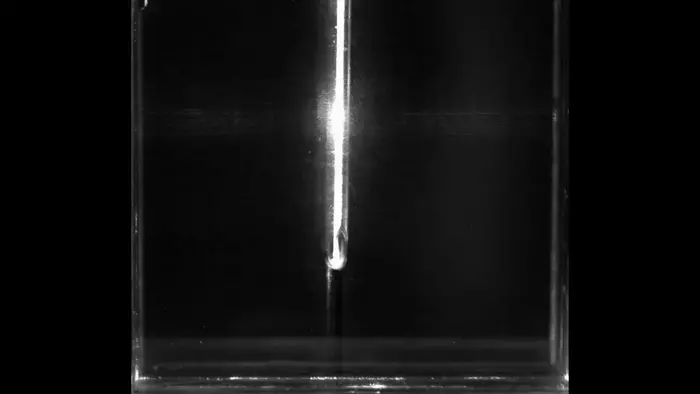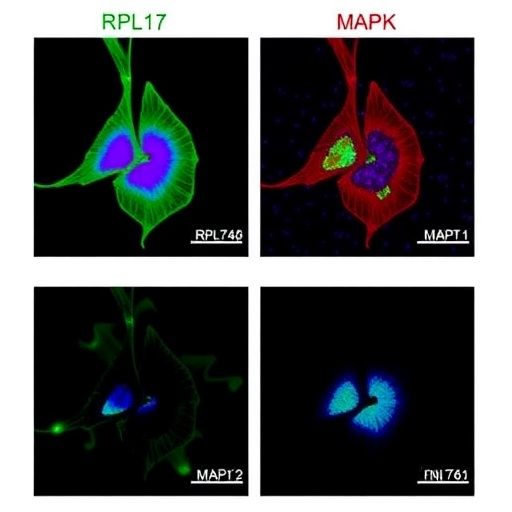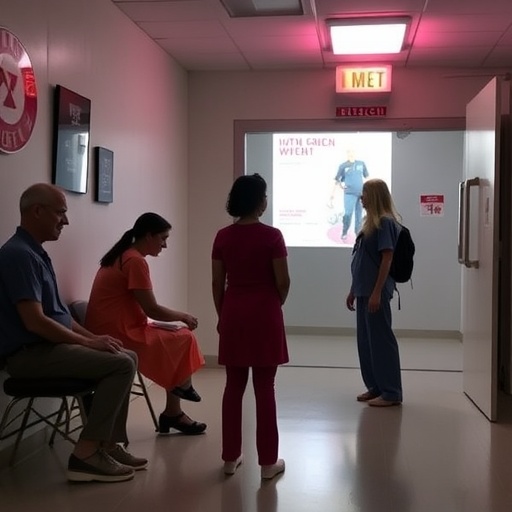Mathematicians are using their expertise to improve IVF success rates, according to a new study.

Credit: • Lab_OldNeedle and Lab_NewNeedle are videos taken at the Oxford Fluid Dynamics Laboratory by collaborator and co-author Prof. Alfonso Castrejon-Pita, who should be credited. They show how the old needle sends fluid forward, while the new needle re-directs it laterally.
Mathematicians are using their expertise to improve IVF success rates, according to a new study.
A team of researchers have redesigned the needle used in IVF procedures, helping to increase the likelihood of having a baby through this treatment. The study, published in the Journal of Biomechanics, is a culmination of five years research into fertility.
During IVF, eggs (known as oocytes) are taken from a person’s ovaries and fertilised with sperm in a laboratory. Once fertilised, the egg becomes an embryo – which is then inserted into the womb to grow.
Gathering oocytes is invasive and expensive and, according to computer models, current techniques successfully collect only 60% of available oocytes. The more oocytes that can be harvested, the more chance of a successful pregnancy.
This latest modelling research, led by Radu Cimpeanu, Associate Professor at Warwick Mathematics Institute, University of Warwick, has helped to improve the efficacy of the needles used in oocyte extraction. The team achieved this through mathematical and computer models, which helped them study the complex flow of liquid through the needles used in IVF.
They showed that in traditional IVF methods, when the needle is inserted into follicles (which contain oocytes) in the ovary, the flow of fluids through the needle can damage the oocytes.
To address this, the team redesigned the needle to have specialised lateral channels, steering fluid flow inside the follicle to gently move the oocyte towards the hollow tip of the needle. This means that oocytes are less likely to become stuck or damaged during extraction, improving collected numbers considerably at this early stage of the procedure – thereby improving IVF success rates.
Professor Radu Cimpeanu said: “The study represents a fantastic interdisciplinary undertaking, with medical practitioners, engineers and mathematicians coming together to solve a problem from a completely new direction. The study began in 2018, while I was at the University of Oxford, and quickly developed into an international collaboration. Seeing the models come to life as prototypes used in real-world studies has been an incredibly rewarding experience.”
Dr. Ektoras Georgiou, Subspecialist Registrar in Reproductive Medicine & Surgery, University Hospital Southampton NHS Foundation Trust, said: “’Modern IVF is a long and arduous process and its success rate is modest, at best. After leading a systematic review which demonstrated that the practice of follicular flushing does not improve oocyte yield or IVF outcomes, I found myself wondering how this now outdated process could be improved. It has been so exciting to be able to bring together a team of experts across different fields, who share in my passion to drive innovation in an evidence-based and scientific approach.”
Professor Cimpeanu added: “We’ve also worked with collaborators at the University of Nottingham and the Paragon Veterinary Group to successfully deliver this new type of needle in IVF procedures in cattle. We are currently laying the foundations for human trial studies and are in discussions with manufacturers to try to implement this new model at scale.
“Alongside IVF, the research could have wide-reaching benefits, improving the use of needles in a range of medical treatments.”
Read the paper here: https://www.sciencedirect.com/science/article/pii/S0021929023004037?via%3Dihub
Notes to Editors
Media contact
University of Warwick press office contact:
Annie Slinn 07876876934
Communications Officer | Press & Media Relations | University of Warwick Email: [email protected]
Images and videos
All available here – credit the University of Warwick.
Videos descriptions
• Lab_OldNeedle and Lab_NewNeedle are videos taken at the Oxford Fluid Dynamics Laboratory by collaborator and co-author Prof. Alfonso Castrejon-Pita, who should be credited. They show how the old needle sends fluid forward, while the new needle re-directs it laterally.
• the ComputerModel videos showcase the effect of this in the simulation counterpart, in which you can see how the oocyte is largely unaffected by the action of the old needle (it stays in place until flushing is stopped) and then gets crushed/damaged on the side of the needle wall. By contrast, the new needle sets the flow in motion (the colours show the vortices/vortical structures mentioned before, they are what makes the flow nice and active) and delivers the oocyte closer to the tip of the needle, where at some point it gets aspirated in the same case (the same oocyte initial location) in which the previous old needle had failed to do so. In each of these left shows the follicular wall/oocyte in motion, while the right shows the vorticity, which is this flow quantity that is useful to monitor to see where the action happens.
Journal
Journal of Biomechanics
DOI
10.1016/j.jbiomech.2023.111832





